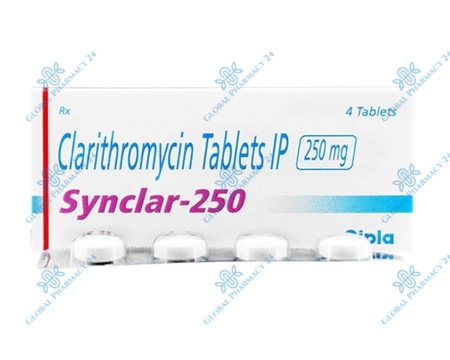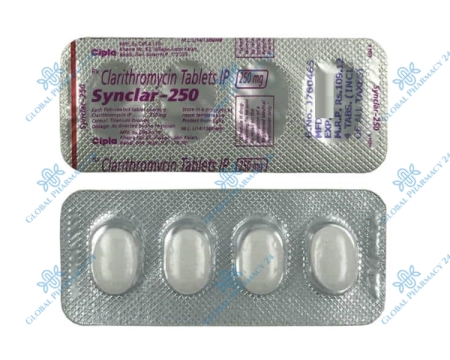| Dosage Form | Active Ingredient | Duration of Action | Indications | Contraindications |
|---|---|---|---|---|
| Oral suspension, Tablets | Clarithromycin | 24 hours | Bacterial infections, H. pylori eradication | Hypersensitivity to macrolides, concomitant administration with certain medications |
Diving into the World of Synclar
Synclar, known for its active ingredient clarithromycin, has emerged as a cornerstone in the treatment of various bacterial infections. Its development marked a significant milestone in the field of antibiotics, providing a potent option for clinicians in the battle against resistant bacterial strains. The drug's formulation allows for efficient absorption and distribution, making it a reliable choice for managing infections.
The journey from its discovery to widespread clinical use underscores the importance of macrolides in modern medicine. Synclar's ability to target a broad spectrum of bacteria, including those responsible for respiratory, skin, and soft tissue infections, highlights its versatility and effectiveness. The ongoing research into its mechanisms and potential new indications continues to expand its therapeutic reach.
A Peek into the Development of Synclar
The development of Synclar was driven by the need for more effective antibiotics capable of combating macrolide-resistant bacteria. Its introduction followed extensive research into the pharmacological properties of clarithromycin, aiming to optimize its absorption, efficacy, and safety profile. This effort has resulted in a medication that significantly improves patient outcomes in bacterial infections.
Understanding Synclar: Composition and Characteristics
Synclar is composed of clarithromycin, a semi-synthetic derivative of erythromycin. This composition enhances its stability and acid resistance, allowing for better oral bioavailability. Clarithromycin acts by inhibiting bacterial protein synthesis, a mechanism that underlies its broad antibacterial activity. Its characteristics include a favorable pharmacokinetic profile, facilitating widespread use in various infectious disease settings.
Pharmacology of Synclar
The pharmacological prowess of Synclar lies in its mechanism of action and pharmacokinetics, which together ensure its efficacy against a wide array of bacterial pathogens. By selectively binding to the 50S ribosomal subunit of susceptible bacteria, Synclar inhibits protein synthesis, leading to bacterial growth arrest and cell death. This mode of action is particularly effective in treating infections caused by Gram-positive and some Gram-negative bacteria, as well as certain atypical pathogens.
Understanding the pharmacokinetics of Synclar is crucial for optimizing its clinical use. After oral administration, clarithromycin is rapidly absorbed, with its bioavailability enhanced by its acid stability. It undergoes hepatic metabolism, with active metabolites contributing to its antibacterial activity. The drug's elimination half-life allows for twice-daily dosing, simplifying treatment regimens and improving patient adherence.
The Dynamics of Synclar: How it Works
Synclar's efficacy is rooted in its ability to disrupt bacterial protein synthesis, a critical process for bacterial growth and survival. This action is both bacteriostatic and bactericidal, depending on the concentration of the drug and the susceptibility of the bacteria. Its broad-spectrum activity encompasses many pathogens responsible for common and severe infections, making it a versatile tool in antimicrobial therapy.
Synclar's Journey in the Body: Pharmacokinetics
The pharmacokinetics of Synclar reveal its efficient absorption and distribution throughout the body, achieving therapeutic concentrations in various tissues, including the lungs, skin, and soft tissues. Its metabolism in the liver and subsequent renal and biliary excretion illustrate the body's ability to process and eliminate the drug effectively, contributing to its safety profile when used according to guidelines.
Exploring the Therapeutic Spectrum of Synclar
Synclar's therapeutic spectrum is impressively broad, covering a range of infections from common respiratory tract infections to more complex diseases like Helicobacter pylori-associated ulcers. Its role in treating and managing these conditions is well-documented, offering clinicians a reliable option for both acute and chronic infections. The drug's efficacy in eradicating H. pylori has further solidified its position in treatment protocols, providing a foundation for the prevention of gastric ulcers and cancer.
Beyond its established uses, ongoing research continues to explore Synclar's potential in treating non-tubercular mycobacterial infections and other less common but significant bacterial diseases. This exploration underscores the drug's versatility and potential for broader application in infectious disease management, highlighting its importance in the antibiotic arsenal.
Synclar: A Weapon Against General Infections
Synclar's broad antibacterial activity makes it an effective weapon against a variety of general infections, including those affecting the respiratory tract, skin, and soft tissues. Its ability to target both typical and atypical pathogens ensures comprehensive coverage, making it a go-to option for clinicians treating these common conditions.
Non-Tubercular Mycobacterial Infections and Synclar
The efficacy of Synclar extends to the treatment of non-tubercular mycobacterial infections, a challenging and emerging area in infectious disease. Its role in managing these infections is a testament to its broad-spectrum activity and highlights the need for ongoing research to fully understand its potential in this context.
Synclar’s Role in Battling Helicobacter Pylori
In the fight against Helicobacter pylori, Synclar stands out for its effectiveness in eradication regimens. Its inclusion in therapy protocols has significantly improved treatment outcomes, reducing the risk of gastric ulcers and potentially preventing gastric cancer. This role exemplifies the drug's impact on public health, beyond its immediate antibacterial action.
Side Effects of Synclar: What to Expect
Patients taking Synclar may experience a range of side effects, from mild gastrointestinal symptoms to more serious conditions such as hepatotoxicity or QT prolongation. Recognizing these potential adverse reactions early is key to managing them effectively, ensuring the continued safety and efficacy of the medication.
Interactions of Synclar: A Crucial Aspect
The interactions between Synclar and other medications can significantly influence treatment outcomes. This includes potentiation of effects, as seen with certain statins or anticoagulants, and reductions in therapeutic efficacy when used with drugs inducing cytochrome P450 enzymes. Clinicians must navigate these interactions with care to maintain the therapeutic integrity of Synclar.
Unraveling Synclar’s Administration: Dosage and Guidelines
The administration of Synclar follows specific dosage and guideline recommendations to maximize its therapeutic benefits while minimizing risks. For most infections, the standard regimen involves oral administration twice daily, tailored to the severity and type of infection. Adhering to these guidelines is crucial for achieving the desired outcomes, emphasizing the importance of patient education and compliance.
Special considerations in dosage and administration are warranted for certain populations, such as patients with renal impairment or those at risk for prolonged QT interval. These scenarios require adjustment of dosages or careful monitoring, underscoring the need for individualized treatment plans based on patient-specific factors.
Recommended Dosage for Various Indications
The recommended dosage of Synclar varies depending on the indication, ranging from the treatment of acute bacterial exacerbations of chronic bronchitis to the eradication of H. pylori in peptic ulcer disease. These dosages reflect the drug's efficacy across its therapeutic spectrum, providing a framework for clinicians to tailor treatment to individual patient needs.
Special Considerations: Usage in Different Populations
Special considerations in the use of Synclar include adjustments for patients with renal or hepatic impairment, where dose reductions or increased monitoring may be necessary. Additionally, the drug's use in pediatric and geriatric populations requires careful consideration of dosing and potential side effects, ensuring safe and effective treatment across all age groups.
Synclar in the Competitive Pharmaceutical Market
In the competitive pharmaceutical market, Synclar stands out for its broad-spectrum antibacterial activity and established efficacy. Its comparison with other macrolides reveals distinct advantages, including improved bioavailability and a broader range of indications. However, the presence of newer antibiotics and the ongoing issue of antibiotic resistance pose challenges to its market position.
The comparative analysis of Synclar with other macrolides highlights its strengths and areas for improvement. As the medical community continues to confront the challenge of bacterial resistance, the role of Synclar and similar antibiotics will be critical in developing effective treatment strategies.
Table: Comparative Analysis of Synclar with Other Macrolides
| Feature | Synclar (Clarithromycin) | Other Macrolides |
|---|---|---|
| Spectrum of Activity | Broad, including atypical pathogens | Varies, generally narrower |
| Bioavailability | High | Varies |
| Indications | Wide range, including H. pylori eradication | More limited |
| Drug Interactions | Significant, requires monitoring | Less significant in some alternatives |
The Closing Note: Synclar in Real Life
In real-life settings, Synclar's role extends beyond its clinical indications, impacting patients' lives through its efficacy and the management of its adverse effects. The balance of benefits and risks is a constant consideration, with patient experiences and outcomes providing valuable insights into its real-world application.
The integration of patient perspectives into the evaluation of Synclar highlights the importance of considering both clinical efficacy and quality of life in its use. Stories and testimonials from patients who have benefited from Synclar, as well as those who have experienced side effects, contribute to a comprehensive understanding of its place in therapy.
Advantages and Disadvantages: Weighing the Pros and Cons
- Pros:
- Broad-spectrum antibacterial activity
- Effective in H. pylori eradication
- Generally well-tolerated
- Cons:
- Potential for significant drug interactions
- Side effects, including gastrointestinal symptoms and liver enzyme elevations
- Risk of antibiotic resistance with improper use
Patient Perspectives: Testimonials and Stories
Patient testimonials and stories about Synclar shed light on its impact from a personal perspective, offering insights into its effectiveness and the challenges of managing side effects. These narratives underscore the importance of patient-centered care and the need for ongoing support and monitoring during treatment with Synclar.
FAQs Synclar
What is Synclar?
Synclar is a revolutionary new product designed to...
How does Synclar work?
Synclar works by...
Is Synclar safe to use?
Yes, Synclar has undergone extensive testing...
What are the main benefits of using Synclar?
The main benefits of Synclar include...
Can Synclar be used by people of all ages?
Synclar is suitable for individuals of all ages...
Where can I purchase Synclar?
Synclar is available for purchase at...





















